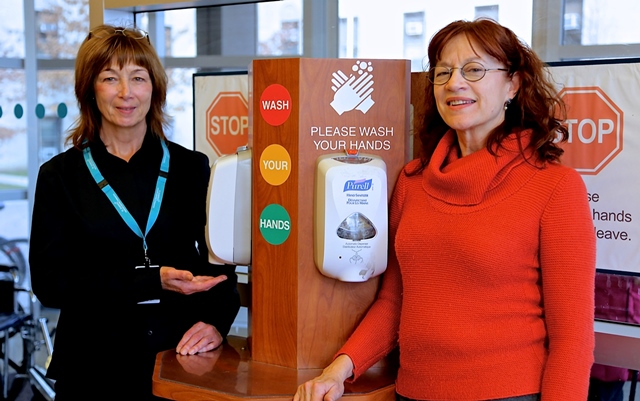You’ve heard it many times before, from many people – make sure you wash your hands! There’s good reason for it – hand washing stops germs dead in their tracks, especially in a hospital setting where germs and infections can spread easily.
That’s why a simple mantra – clean hands save lives – is integral to our approach in providing the safest care to our patients. But it’s more than just a slogan that makes a campaign successful and over the last two years we have taken a hard look at our data and our program to create solutions and practices to enhance our hand hygiene compliance and reduce hospital acquired infections like C. difficile.
Bold changes like inviting patients to help redesign our program and introducing new technology and working with volunteer observers to make monitoring compliance easier and more accurate are helping to improve our results.
St. Joseph’s had a formal hand hygiene program in place since 2009 when Ontario began publicly reporting data. This included staff and physician education on appropriate hand washing techniques and a paper- based auditing system that tracked how often teams were following the four moments of hand hygiene (the key moments when care providers wash their hands before and after interacting with patients).
MORE: THE DIGITAL HEALTH REVOLUTION
In the first year of publicly reporting hand hygiene data, St. Joe’s had a compliance rate of 95 per cent. Despite our high compliance rate, we were still seeing a high number of patients who contracted C. difficile, a type of bacteria that can be found in stool and causes diarrhea, fever and abdominal pain.
“Evidence-based science points to proper hand washing as being the number one way to prevent the transmission of infection,” says Stefania Cloutier, Infection Control Practitioner at St. Joe’s. “If you have a 95 per cent (hand hygiene) compliance rate, you really shouldn’t see a lot of hospital acquired infections,” says Cloutier. “And we were seeing a monthly average of about seven C. difficile cases during this time.”
Recognizing this challenge, we used it as an opportunity to review our infection control data, and take some important steps to make an improvement to our hand hygiene program.
Dr. Jennie Johnstone, St. Joe’s Infection Control Officer, began to design a formal quality improvement project with a number of goals that included engaging independent volunteer observers who would be specially trained to conduct hand hygiene audits so we could move away from the “colleagues-observing-colleagues” approach. It was also necessary to move to an electronic platform to collect audit data to help ensure we would receive a true picture of hand hygiene compliance across the organization and to allow us to easily analyze the numbers by unit or by health care provider type.
In 2013, we launched this new approach to our hand hygiene program. Trained volunteers began conducting hand hygiene audits on the units, tracking their observations using an electronic tool called HandyAudit. By using this platform, it allowed them to input only what they observed with hand washing practices, with the system generating a pass or fail on compliance.
MORE: LONDON HEALTH SCIENCES CENTRE PREPARES FOR ITS ROLE AS EBOLA HOSPITAL
With these changes, our hand hygiene compliance rate for the 2013/14 fiscal year dropped to 42 per cent. Barley Chironda, Interim Manager of Infection Control says it was a transparent move for our organization to show the change in compliance rate that resulted from removing the barriers discovered in our quality improvement processes. “This gave us the starting point we needed so our teams could do the right work that needed to be done to improve,” he says.
Another change we made to our program was to bring the patient’s voice and ideas to the table. Diane McKenzie and Alies Maybe, two of our Patient and Family Advisors, are supporting our hand hygiene initiatives by helping us explore new and better ways to engage with our patients, staff and physicians to raise awareness on the importance of hand hygiene and improve our compliance.
“St. Joe’s is my hospital and it’s been the hospital for my children also,” says McKenzie. “I care about my hospital and my community, so I was honoured to be accepted (as an advisor) and to know that my voice would be heard.”
McKenzie has engaged directly with patients and families in several inpatient units to get their feedback about hand hygiene and to better understand their hospital experience and what they have observed. In addition to sharing this feedback with our hand hygiene working group, she teamed up with our Infection Control team for a Patient Safety Week presentation to staff, where discussions focused on how we can collectively improve compliance rates as an organization and what that means for our patients.
When compliance was at 42 per cent, St. Joe’s was seeing on average five cases of C. difficile per month. “With our current hand hygiene rate of 76 per cent we are close to zero [C.difficile cases] – so we are above the ratio,” says Chironda. “There are other factors that contribute to lower infection rates including antibiotic stewardship and enhanced cleaning practices, but the data is showing us that the more people wash their hands, the lower our infection rates are.”
MORE: THE EVOLUTION OF AN ORGANIZATION
Work continues to move the needle to improve our hand hygiene compliance and we have seen success in surpassing our initial target of 70 per cent. We’re also working closely with our partners across the system to embed best practice standards into our processes. Knowledge sharing and collaboration with national organizations like the Canadian Patient Safety Institute and the Joint Centres for Transformative Healthcare Innovation at the local level are important partnerships we strongly value and learn from in our quality improvement journey.
“We’ve invested more time and effort to make positive changes,” says Dr. Johnstone. “Everyone is committed to providing safe care to our patients and I’m confident that the hard work of our dedicated teams across the organization, our Infection Prevention and Control team and our Hand Hygiene working group will continue to drive our compliance rate even higher.”




